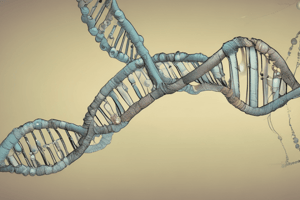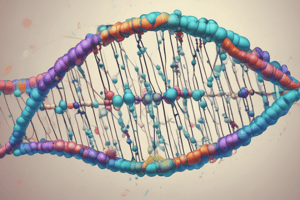Podcast
Questions and Answers
Which process involves the exchange of genetic information?
Which process involves the exchange of genetic information?
- DNA translation
- DNA recombination (correct)
- DNA transcription
- DNA replication
Which type of DNA recombination occurs as a reciprocal exchange between identical or nearly identical sequences?
Which type of DNA recombination occurs as a reciprocal exchange between identical or nearly identical sequences?
- Intermolecular recombination
- Homologous recombination (correct)
- Intramolecular recombination
- Non-homologous recombination
What is the main difference between homologous recombination and non-homologous recombination?
What is the main difference between homologous recombination and non-homologous recombination?
- Homologous recombination occurs between paternal and maternal chromosomes, while non-homologous recombination occurs between different sequences. (correct)
- Homologous recombination occurs as random insertion of viral genome, while non-homologous recombination occurs between identical or nearly identical sequences.
- Homologous recombination occurs as a non-reciprocal exchange, while non-homologous recombination occurs as a reciprocal exchange.
- Homologous recombination occurs with limited sequence homology, while non-homologous recombination occurs with high sequence homology.
Which type of homologous recombination occurs between two separate homologous molecules?
Which type of homologous recombination occurs between two separate homologous molecules?
What is the biological role of recombination?
What is the biological role of recombination?
Which type of DNA recombination occurs as a non-reciprocal exchange between different sequences with limited sequence homology, such as random insertion of viral genome?
Which type of DNA recombination occurs as a non-reciprocal exchange between different sequences with limited sequence homology, such as random insertion of viral genome?
What is the term for homologous recombination that occurs between two separate homologous molecules?
What is the term for homologous recombination that occurs between two separate homologous molecules?
Which type of homologous recombination produces a circular DNA and a linear short DNA?
Which type of homologous recombination produces a circular DNA and a linear short DNA?
What is the main biological role of recombination?
What is the main biological role of recombination?
During which process does homologous recombination occur?
During which process does homologous recombination occur?
Flashcards are hidden until you start studying
Study Notes
DNA Recombination
- Genetic information is exchanged through a process called DNA recombination.
- Homologous recombination occurs as a reciprocal exchange between identical or nearly identical sequences.
- Homologous recombination differs from non-homologous recombination in that it involves the exchange of genetic information between identical or nearly identical sequences.
- Inter-molecular homologous recombination occurs between two separate homologous molecules.
- The biological role of recombination is to increase genetic diversity and facilitate the repair of DNA damage.
- Non-homologous recombination occurs as a non-reciprocal exchange between different sequences with limited sequence homology, such as random insertion of viral genome.
- Inter-molecular homologous recombination is also known as inter-chromosomal recombination.
- Single-strand annealing produces a circular DNA and a linear short DNA.
- The main biological role of recombination is to increase genetic diversity and facilitate the repair of DNA damage.
- Homologous recombination occurs during meiosis, a process of cell division that produces gametes (sperm or egg cells).
Studying That Suits You
Use AI to generate personalized quizzes and flashcards to suit your learning preferences.




